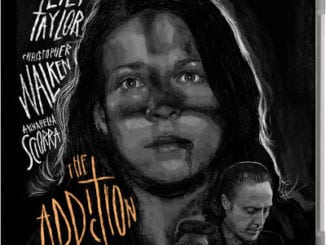
Gothic legends… haunted houses… ancient curses… vampires and serial killers… welcome to the spine-tingling world of Italian director Mario Bava. In a career spanning four decades Mario Bava inspired multiple generations of filmmakers, from Dario Argento to Tim Burton. For his final feature, Shock starring horror icon Daria Nicolodi (Deep Red), he eschewed the grand guignol of his earlier classics for a more intimate, but no less frightening, portrait of mental breakdown in which true horror comes from within. Now restored in high definition for the first time, the Maestro of the Macabre’s chilling swansong disturbs like never before in a stunning new release from Arrow, available in January on Blu-ray (including a special O-card limited edition) and on the ARROW streaming service. To celebrate the release, here’s a look at ten of Bava’s finest, and most chilling films.
BLACK SUNDAY (1960)
Horror… Anguish… and Terror! Legendary Scream Queen Barbara Steele (Shivers, Caged Heat) stars in this classic slice of gothic terror from Bava. Steele is a beautiful witch who is sentenced to death for her evil deeds by her own brother, condemned to die by having a metal mask hammered onto her face before being burnt at the stake. As she passes, she puts a terrible curse on all her future descendants as the spikes of the death mask pierce her flesh… But when two unwitting travellers discover her final resting place and worse, drip blood on her resting corpse, they unleash her once again in all her stunningly beautiful, terrifying glory. Banned in the UK on its release, Bava’s groundbreaking film that opened the door for ‘Spaghetti horror’ in all its gory glory.
BLACK SABBATH (1963)
Bava’s directs a delectable anthology horror comprising three individual narratives. In ‘The Telephone’ a woman (Michèle Mercier) is tormented by a former lover who has been released from prison; in ‘The Wurdalak’ a man (Boris Karloff) returns home having been turned into a vampire; and in ‘The Drop of Water’ a nurse (Jacqueline Pierreux) is tormented by strange goings-on after she steals a ring from the corpse of an elderly woman.
BLOOD AND BLACK LACE (1964)
The Christian Haute Couture fashion house is a home to models… and backstabbing… and blackmail… and drug deals… and MURDER. Having established a template for the giallo with The Girl Who Knew Too Much, Mario Bava set about cementing its rules with Blood and Black Lace. In doing so he created one of the most influential thrillers ever made – an Italian classic that would spearhead the giallo genre, provide a prototype for the slasher movie, and have a huge effect on filmmakers as diverse as Guillermo del Toro and Martin Scorsese.
PLANET OF THE VAMPIRES (1965)
A band of space travelers has just intercepted a distress call from a distant world! Is it a desperate cry for help… or something far more sinister? After landing on the shadowy planet, the crew is attacked by a horde of disembodied aliens with a diabolical plan: to conquer the universe by controlling the crew’s minds and stealing their souls. Bava imbues this eerily photographed and electrifying sci-fi horror with an intoxicating, feverish atmosphere of dread.
HATCHET FOR THE HONEYMOON (1970)
Bava’s superlative early 70s masterwork sees troubled protagonist John Harrington (Stephen Forsythe) turning to a life of serial killing. Refused a divorce by his uncaring wife, and haunted by childhood trauma John takes out his murderous frustrations on a string of would-be brides who innocently cross his path. Undoubtedly an influence on later movies like Maniac (1980), and a host of other chillers, this often-overlooked piece from one of Europe’s finest, is a smart, beautifully stylised, gory delight.
A BAY OF BLOOD (1971)
A family’s murderous battle over some bayfront property is the subject of Bava’s bloody horror-thriller, which many have cited as the grandfather of the modern slasher film. There are throat hackings, face choppings and spears through copulating bodies – murder scenes that were all imitated in Steve Miner’s Friday the 13th, Part 2 and the film’s style influenced countless American slasher films of the 1970s and ’80s. Bava also includes a strangulation by telephone cord, a gory axe decapitation, a man speared to a wall, and five other ingenious kills.
BARON BLOOD (1972)
One of Bava s biggest hits, Baron Blood returns to the all-stops-out Gothic atmosphere and the central theme of a witch’s curse that fuelled his breakthrough film Black Sunday twelve years earlier. This time, the curse was placed on Baron Otto von Kleist, Austria s legendarily murderous Baron Blood, whose corpse is inadvertently revived when an ancient incantation is read out as a joke by a descendant and his girlfriend. Naturally, the Baron decides to carry on where he originally left off, with the help of an entire vault of elaborate torture devices. Joseph Cotten (Citizen Kane, The Third Man) is terrific as the deceptively charming Baron, and is given sterling support from Elke Sommer (Bava’s Lisa and the Devil, next on the list), who is chased through fog-shrouded alleyways in one of Bava s most memorably atmospheric set-pieces.
LISA AND THE DEVIL (1973)
A tale of nightmarish surrealism and supernatural suspense from the master! Lisa (Elke Sommer) – an American tourist travelling in Spain – loses her tour party and seeks refuge in the tumbledown mansion of a blind countess after being guided there by the distinctly satanic butler of the house, Leandro (Telly Savalas, Horror Express, Kojak). The Son of the Countess notices Lisa’s striking resemblance to his dead lover and pursues her as a night of murder, strange eroticism and dark hallucinations begins. This is Bava at his abstract and delirious best, delivering a 70s horror classic and a masterclass in cinema as a feverish nightmare.
RABID DOGS (1974)
Following difficulties in his career Mario Bava happened across an idea that would enable him to compete with the younger directors lighting up the Italian box office such as Dario Argento and Sergio Martino. Rabid Dogs begins as $70,000 of wages are being transferred when the Ajaccio gang hit. With a hail of bullets in a quick raid they speed off in their waiting getaway car. Tough, violent and realistic, Bava s film ramps up the tension and doesn t stop as hostages are added and the film builds to its dizzying finale. Unfolding in real time, a rare device seen only in earlier films such as High Noon and 12 Angry Men yet totally unheard of in Italian cinema at the time, Rabid Dogs is a singular film in Bava’s filmography, one of the great crime films of the period, and a breathless, nail-shredding viewing experience.
SHOCK (1977)
Dora (Daria Nicolodi, Deep Red) moves back into her old family home with her husband, Bruno (John Steiner, Tenebrae), and Marco (David Colin Jr., Beyond the Door), her young son from her previous marriage. But domestic bliss proves elusive as numerous strange and disturbing occurrences transpire, while Dora is haunted by a series of nightmares and hallucinations, many of them involving her dead former husband. Is the house itself possessed? Or does Dora’s increasingly fragile grip on reality originate from somewhere far closer to home? Released in the United States as a sequel to Ovidio G. Assonitis’s Beyond the Door, Shock more than lives up to its name, proving that, even at this late stage in his career, Bava hadn’t lost his touch for terror.
SHOCK is available now on the essential, alternative streaming service ARROW and 17th January on Limited Edition Blu-ray courtesy of Arrow Video





Be the first to comment